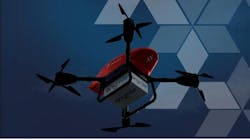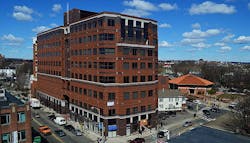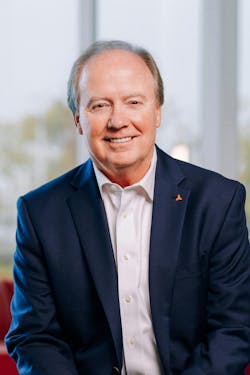Mitsubishi Electric: Speculative Tech Development While Staying Practical
Sometimes you just need to improve existing products. But it can be more fun to develop technology when you have no idea what the hell you’re going to do with it.
Mike Corbo, president and CEO of Mitsubishi Electric U.S., says the company is investing heavily in U.S. production (see sidebar), but it also sees America as a fertile ground for another type of growth—new ideas. The spirit of Silicon Valley startup culture that pervades accelerators and incubators in the United States presented an opportunity Mitsubishi Electric could not pass up.
“Japanese business processes are very specific and very unique. The U.S. process is also a little more entrepreneurial in ways,” Corbo says. “I’ve always talked about the convergence of the two being the ideal, a little more discipline on the American side…and a little more entrepreneurial spirit from the Japanese side.”
Practical East, Experimental West
Mitsubishi Electric manages a huge product portfolio for power, space, factory automation, energy, semiconductors, mobility, elevators, escalators and HVAC. Historically, internal projects alone served the company’s innovation needs, says Corbo.
Mitsubishi Electric Places Big Bets on American Manufacturing
Mitsubishi Electric acknowledges that overseas markets, with particular attention toward the United States, currently represent 52% of the company's revenue and offer greater potential for growth than the domestic Japanese market.
“There’s a lot more investment happening in the United States, local production for local consumption has been happening over the last several years, and we see the market opportunity in the United States as significant,” Corbo says.
- December 2024: $143.5 million in its Maysville, Kentucky, plant to grow its HVAC parts business
- March 2025: $86 million new plant for Mitsubishi Electric Power Products Inc. in New Galilee, outside Pittsburgh, Pennsylvania.
Software development, however, became a concern. Mitsubishi Electric for decades wrote software for its hardware, but as the market changed and software became a discrete product, siloed innovation couldn’t serve the company’s needs.
“Developing in-house, we’ve made great hardware over the years,” Corbo says. “We’re recognized for quality. But beyond that, the area to innovate and develop software solutions, we needed to go outside. We need to go faster, and we recognize that opportunity through open innovation.”
In 2020, Mitsubishi Electric Corp. established the Business Innovation Division, looking initially at areas inside their core businesses where the division could innovate and accelerate change. Two years later, Mitsubishi Electric announced the creation of a corporate venture capital (CVC) fund in partnership with Global Brain Corporation. VC investment continues today with Collaborative Fund in 2024, and Blackhorn Ventures and Remarkable Ventures in 2025.
In the United States, the Mitsubishi Electric Research Lab (MERL) in Cambridge, Massachusetts, started in 1991 and by 2007 absorbed different labs for computer hardware and television hardware to become a hub for fundamental research. In 2019, Mitsubishi Electric Corporation U.S. acquired ICONICS, since renamed Mitsubishi Electric Iconics Digital Solutions (MEIDS), primarily a developer of SCADA software, to increase its footprint in the IoT sector.
There was still something missing in Mitsubishi’s innovation portfolio in the U.S. The company took advantage of collaborative opportunities in the United States with accelerators and startups such as Greentown Labs, MassRobotics and Plug and Play, but the Silicon Valley model was limited to these external partnerships.
AI Today Leaves No Room to Delay
Working with and observing these companies, Mitsubishi Electric U.S. learned how to structure its own internal incubator and accelerator programs. This May, the company announced the Mitsubishi Electric Innovation Center (MELIC) in Cambridge, the final piece of the innovation puzzle in the U.S. Where MERL focuses on fundamental research, MELIC focuses on creating new products and solutions.
“We utilize multiple innovation instruments in a very holistic way… VC funds, CVC fund… capstone projects with universities and public challenges, similar to what Kaggle offers,” says Zafer Sahinoglu, formerly a research scientist at ME for 14 years and currently VP of innovation and general manager at MELIC.
As with venture capital arms such as BMW i Ventures and Toyota Ventures, MELIC doesn’t plan on limiting investments to technologies that immediately serve business units. Take, for example, one of the center’s star projects, AnyMile.
“It’s a SaaS platform for aerial logistics. When you are doing a drone-based delivery, AnyMile helps you manage your resources and key activities, from submitting a shipment request to dispatching your resources to complete a mission… service work orders for parking a drone, fueling it and repairing it… a very holistic platform,” Zafer says.
“When you look at AnyMile in its current shape, it’s not related to any of Mitsubishi Electric’s core businesses. It’s outside the core but we invested in it. We believed in this emerging market, and it is commercialized right now.”
The AnyMile investment perfectly represents MELIC’s mission, tapping directly into the spirit of rapid commercial innovation, following the Silicon Valley formula of rapidly going to market with innovative products, but without depending on external VC firms.
With AI greatly increasing software development speed, Zafer says there was no time to delay opening MELIC. Several years ago, he built a product with a team of 10 software engineers that took two years to complete and make ready for customers. Just as an experiment, Zafer used agentic AI tools to recreate the same product. It took only two months and required two developers.
“That’s exciting and also concerning, that if it is so easy now to create a product or a service for my competitors, they may quickly displace me and vice versa,” Zafer says.
Software Closes the Loop
Mitsubishi Electric leverages a digital platform called Serendie (“Where serendipity meets digital engineering,” Corbo quips), launched in 2024 to collect data across all its business verticals to improve existing products and create new ones.
In January, the company announced the completion of a physical collaboration space in Yokohama, Japan, called Serendie Street, where employees from different business units collaborate on developing software advancements.
“Software you’re developing for one business area often directly impacts another business area and can be used to leverage it. We want more of that collaboration aspect and less individual development of software solutions inside the businesses themselves,” Corbo says.
This Fall, Mitsubishi Electric U.S. plans to open its own version of the collaboration center, Serendie Street Boston, to connect efforts between MERL, MELIC and MEIDS and feed their data into the Serendie platform, as well, unifying innovation efforts between East and West.
“That addresses what we refer to as a circular digital engineering process within Mitsubishi Electric. It’s a continuous process, but it starts with data that’s been available. We haven’t leveraged it as we can, in the past. … That’s what that Serendie digital platform represents for us in Yokohama. We have taken all of those business verticals and brought people together from those verticals and put them together there,” says Corbo.
“That is the long-term vision that we will be doing here as well in the United States. Both platforms are to be collaborating with one another and looking for global solutions, not just solutions here in North America for example, or not just solutions in Japan.”
About the Author
Dennis Scimeca
Dennis Scimeca is a veteran technology journalist with particular experience in vision system technology, machine learning/artificial intelligence, and augmented/mixed/virtual reality (XR), with bylines in consumer, developer, and B2B outlets.
At IndustryWeek, he covers the competitive advantages gained by manufacturers that deploy proven technologies. If you would like to share your story with IndustryWeek, please contact Dennis at [email protected].




